#1934 Worlds Fair
Explore tagged Tumblr posts
Text
The Ford Rotunda: Gateway to the Rouge @FordMotorCompany
IN 1936, FORD’S WORLD’S FAIR EXPOSITION FOUND A PERMANENT HOME IN DEARBORN AND BECAME ONE OF THE MOST POPULAR TOURIST ATTRACTIONS IN THE UNITED STATES. “FORD will participate in the 1934 World’s Fair at Chicago!” exclaimed the March edition of the Ford News. That same spring, Ford Motor Company opened the doors on a new pavilion. Sitting on 11 acres of land along the Lake Michigan shoreline, the…

View On WordPress
#1930&039;s#1934 Worlds Fair#1940&039;s#1950&039;s#Ford Motor Company#River Rouge Plant#The Ford Rotunda Gateway to the Rouge
0 notes
Text
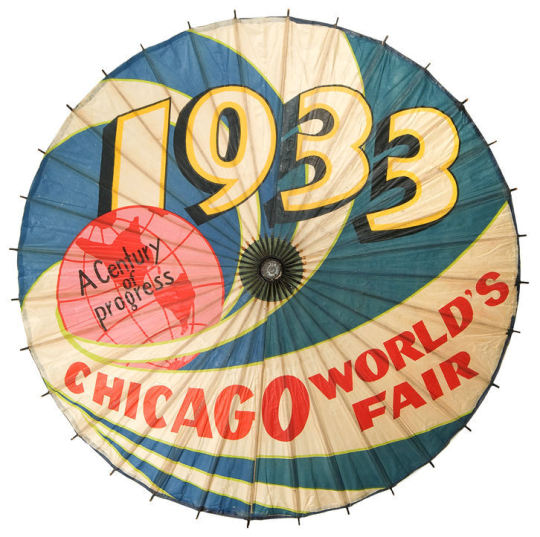
Souvenir parasol from the Chicago World's Fair, 1933-'34.
#1930s#1933#1934#art deco#whirling planet#A Century of Progress#1933 World's Fair#1934 World's Fair#Chicago World's Fair#Chicago#Lake Michigan#parasol#modern#vintage#souvenir#ephemera
46 notes
·
View notes
Text

Happy National Pie Day! What's your favorite pie? Do pot pies count? Because those are my personal favorites!
And these fellas clearly loved a good pie! These are the third, second, and first place winners of a pie-eating contest at the 1934 World's Fair (in Chicago). Bespectacled winner Dennis O'Shea stands to the far right. Edward Jackson (left) won third place, and Bob Callow (middle) won second place.
Source: University of Illinois at Chicago Library (Century of Progress at World's Fair, 1933-1934) [Linked in post]

Follow @agmarietv for more American Pop Culture history!
0 notes
Text
Women, fish, creatures of the night, fools, all ye, gather round as I tell you the tale of the most evil man in the history of the state of New York. Robert Moses, the president of the 1964 New York World's Fair and New York City parks commissioner between 1934 and 1960
1K notes
·
View notes
Text

AUGUST 5, 2024

TOKENISM
Tokenism is the practice of selecting a person from a minority group to give the illusion of diversity or of representation of the minority group’s opinion. Tokenism is racism — or in this case, antisemitism — because it weaponizes the identity of the marginalized person to justify things that hurt that very same marginalized group.
In other words, when you tokenize someone, you’re using them in a way that ultimately will hurt them or the group they are affiliated with.
BECAUSE I KNOW I WILL BE ASKED…
I often highlight the voices of Palestinian dissidents, anti-Hamas Palestinians, and of Palestinians seeking to make peace with Israel. People tend to ask me a very good question: how is this any different than “tokenizing” fringe Jews?
Firstly, I want to make it clear that when I highlight the voices of “fringe” Palestinians, I am in no way claiming that they are necessarily representative of the majority. The overwhelming majority of past and recent surveys and statistics I’ve seen unfortunately suggest otherwise.
Secondly, there is a major, major difference between tokenizing the voices of Jews who minimize antisemitism, both in the Diaspora and in Israel, and uplifting the voices of Palestinians who seek to make peace. Tokenizing Jews who dismiss left-wing or Islamist antisemitism or who believe Israeli Jews are fair targets endanger the rest of us. That’s a far cry from Palestinians who wish to live side by side in peace.
Most importantly, the overwhelming majority of Jews worldwide have all the freedom of speech in the world. They are not risking their lives by sharing their views. Palestinian dissidents in the West Bank and especially in the Gaza Strip are quite literally putting their necks on the line to speak out against their tyrannical leaders. To not understand the difference between this and a Jew living comfortably in Brooklyn is a sign of privilege, of not understanding authoritarian societies. When dissidents speak, whether in Iran or the Palestinian Territories, I believe it’s the duty of the people in the free world to uplift their voices.
SELF-TOKENISM: ASSOCIATION OF GERMAN NATIONAL JEWS
In the earliest days of Hitler’s rule, there was a small group of Jews that supported Hitler. In 1921, a Jewish man named Max Naumann founded a group known as the “Association of German National Jews.”
Following Hitler’s rise to power, the Nazi regime itself never tokenized the Association of German National Jews, but the members of the organization tokenized themselves, particularly when speaking to the press. In 1933, a member of the group, Hans Priwin, issued a statement alleging that reports of the Nazis’ mistreatment of Jews were “stupid lies.” In 1934, the Association issued a statement of support for Hitler.
The Association of German National Jews was especially hostile to the less assimilated Jews from Eastern Europe, who they considered backwards and “racially and spiritually inferior.” They were also hostile to Zionists, as they believed that they were a threat to Jewish integration into wider society. The main goal of the Association of German National Jews was the self-eradication of Jewish identity. To accomplish this sinister motive, they weaponized — and tokenized — their own Jewish identities.
After Hitler’s appointment as German Chancellor in 1933, Jews worldwide protested, boycotting German goods. Instead of supporting the protest, the Association came out against the boycott and issued a manifesto that the Jews in Germany were being “fairly treated.”
In 1935, the Nazis declared the Association of German National Jews illegal and dissolved it. Naumann was arrested by the Gestapo the same day.
TOKENISM: HELENE MAYER
German Jewish fencer Helene Mayer is considered one of the best fencers of all time, having won gold at the 1928 Amsterdam Olympics and placing fifth at the 1932 Los Angeles Games. After Los Angeles, Meyer stayed in California to earn a law degree. In 1933, Adolf Hitler rose to power in Germany, stripping Mayer, who was then banned from her old fencing club, of her rights.
Leading up to the 1936 Berlin Olympics, the United States Olympic Committee was under tremendous pressure to boycott the Games. The head of the US Olympic Committee, Avery Brundage, was a Nazi sympathizer, who convinced Germany to allow one German Jewish athlete to compete to give the impression that Jews in Germany were being treated fairly. In other words, the Nazis needed a token Jew.
Enter: Helene Mayer. Mayer had been living in the United States since her expulsion from her fencing club. Desperate to reclaim her old Olympic glory, Mayer tried out and was selected for the German team. She placed second and gave the Hitler salute on the podium.
After the Olympics, where the Nazi press and government ignored her, Mayer returned to the United States, thus saving herself from the Holocaust. She moved back to Germany in 1952 and died a year later. She never publicly addressed her decision to participate as an athlete under the Nazis, a decision which temporarily sanitized Nazi Germany’s image.
TOKENISM: YEVSEKTSIYA
In 1918, the Soviet Communist Party established a “Jewish branch,” with the consent of Vladimir Lenin. It was named “Yevsektsiya,” meaning “Jewish Sections of the Communist Party.” The mission of the Yevsektsiya was, quite literally, the “destruction of traditional Jewish life, the Zionist movement, and Hebrew culture.”
From the outset, the Yevsektsiya began harassing Zionist Jews. Initially, the Yevsektsiya legally abolished the “kehillas,” the traditional Jewish community organizations. Sometimes, they even burned their offices down. They shut down everything from Jewish political groups to theaters to sports clubs. They raided all Ukrainian “Zionist” offices and arrested every single one of their leaders.
Until their dissolution in 1929, they imprisoned, tortured, and murdered thousands of Jews. The fact that the Yevsektsiya was “Jewish” was central to its purpose. After all, the Soviet regime couldn’t be accused of antisemitism when those shutting down all Jewish cultural and spiritual life were Jews themselves. In other words, the Soviets tokenized the Jewish identities of the Yevsektsiya members to legitimize their systematic persecution of Jews.
According to historian of Soviet history Richard Pipes, “In time, every Jewish cultural and social organization came under assault.”
The Soviet government dissolved the Yevsetskiya in 1929, claiming that it was no longer needed. During Stalin’s Great Purge in the 1930s, virtually all its members were arrested and executed. Some were shot by bullet, some were tortured, and others were sentenced to hard labor in Siberia. A former member even died when the prison he was in refused to supply him with insulin.
TODAY
NETUREI KARTA
Antisemites today continue to uplift fringe Jewish groups to deflect from accusations of antisemitism. The Neturei Karta, for example, are a staple at pro-Palestine protests, despite the fact that they share just about zero values with the progressive left, given their sexism and homophobia, among other things. Their membership does not surpass 5000 people, and they are considered so fringe that even other anti-Zionist Orthodox groups, such as the Satmar, have disavowed them, issuing a cherem (censure, similar to excommunication) against them. The Neturei Karta have friendly relations with the Islamic Republic in Iran and even attended a conference in Holocaust denial in Tehran.
JEWISH VOICE FOR PEACE, IFNOTNOW
Surveys consistently show that between 80-95 percent of Jews support the existence of the State of Israel. Yet politicians and activists often uplift anti-Zionist Jewish groups such as Jewish Voice for Peace and IfNotNow as though they are representative of “true” Judaism. These groups have a long history of regurgitating the propaganda and glorifying, excusing, or justifying the actions of terrorists and terrorist groups responsible for heinous attacks against Jews around the world, including October 7.
HOW NOT TO TOKENIZE JEWS
#1 Before you amplify a Jewish person, pause to think: is there anything in it for you? Are you amplifying us because you care about what we have to say or because our words validate your pre-existing opinions?
#2 Some discussions are intracommunity discussions. You don’t need to speak for us, over us, or weaponize intracommunity discussions to demonize the Jews you dislike.
#3 You cannot adequately support Jewish people if you are not open to hearing about our experiences, even when they don’t align with yours.
#4 Listen to many Jewish voices, and not just voices that you always agree with. It’s also important to listen to Jews of diverse backgrounds, races, sub-ethnic groups, social classes, genders, sexual orientations, and more.
This also means that if you disagree with a person about a topic unrelated to Jewishness or Judaism, you should still be willing to listen when they talk about their Jewish experience. People — Jews included — are multifaceted individuals. You might not always agree with us, but you should understand that no one can speak to the Jewish experience better than we can.
#5 No Jew — not a single one — deserves antisemitism. Antisemitism is not a valid punishment for bad behavior; it’s an ancient, senseless form of hatred that has gotten innocent people murdered for thousands of years. All Jews deserve protection from antisemitism, no matter how good or bad their views and/or behavior. Additionally, antisemitism targeting Jews you dislike always spills over and hurts other Jews. If you do not pursue safety for every single Jew, you are not an ally.
#6 To adequately represent the views of the Jewish community, share the views that are representative of the majority of the Jewish community, not fringe opinions. Don’t uplift a minority voice to pretend that that’s how all of us feel.
#7 Understand that Jews can very much perpetuate antisemitism. Agreeing with a Jewish person doesn’t mean you are not antisemitic.
rootsmetals
Olympics x As a Jew crossover
Sources
273 notes
·
View notes
Text

Relief Panels from the Agricultural Pavilion at the Century of Progress World’s Fair in Chicago, Illinois, USA, 1933-1934
24” (63.5mm) wide x 84” (213.36mm) high
#art deco#art deco design#art deco architecture#art deco style#chicago world's fair#chicago#illinois
241 notes
·
View notes
Text




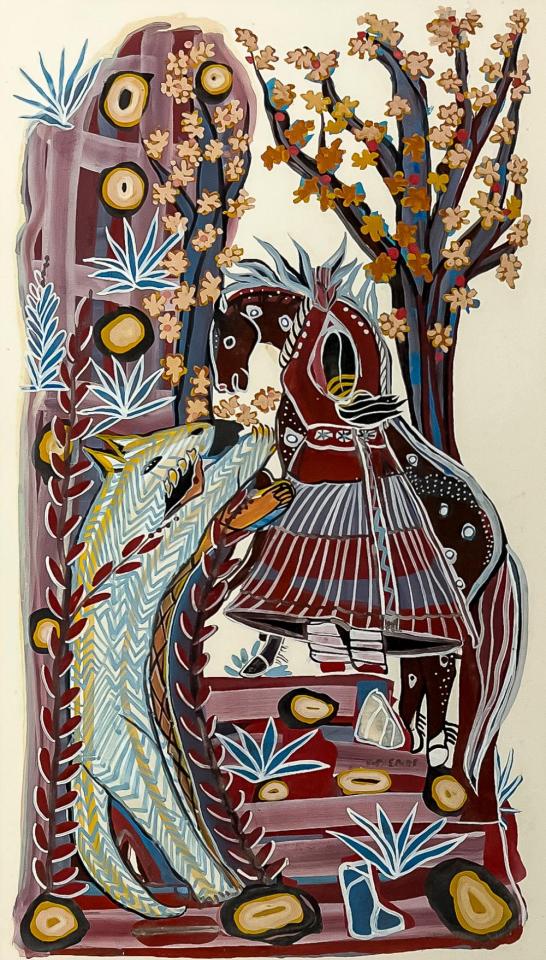



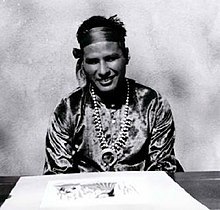

Narciso "Ciso" Platero Abeyta, or Ha So Deh (1918–1998) was a Navajo painter, silversmith and Navajo code talker. He is known for his colorful paintings depicting Navajo life. His work is in the permanent collection of museums including the Smithsonian National Museum of the American Indian.
Abeyta was born in 1918. He is named after his father, Narciso. His mother was Pablita. He started drawing when he was eleven. He attended the Santa Fe Indian School, starting in 1939. Dorothy Dunn was his teacher. Abeyta was a Golden Gloves boxer. He served in World War II in the United States Army, as a code talker. After he returned from service, he was unable to work for ten years due to his experiences at war. Eventually, he attended the University of New Mexico. He trained under Raymond Jonson.
Abeyta was primarily a painter. His paintings document Navajo life, and use brush stroke techniques that are reminiscent of Navajo rugs. He had two known commissions for work as a muralist; a 1934 mural for a social science classroom in Santa Fe, New Mexico and in 1939 for Maisel's Indian Trading Post in Albuquerque, New Mexico. He demonstrated painting at the 1939 San Francisco World's Fair.
Abeyta married Sylvia Ann, a Quaker ceramics artist. They had seven children, including artists Tony Abeyta and Pablita Abeyta. The family lived in Gallup, New Mexico.
64 notes
·
View notes
Text
Hot Vintage Stage Actress Round 5


Dame Julie Andrews: Polly Brown in The Boy Friend (1954 Broadway); Eliza Doolittle in My Fair Lady (1956 Broadway); Queen Guinevere in Camelot (1960 Broadway)
Josephine Baker: Une vent de folie (1927 Paris); Dora in La créole (1934 Paris); Ziegfeld Follies (1936 Broadway)
Propaganda under the cut. Semi NSFW propaganda below cut.
Julie Andrews:
Just a little more Julie propaganda but look how gorgeous she is... I'd let her step all over me even though she'd probably be kind and tell me to chill












Josephine Baker:
where do i even begin, i mean it’s josephine fucking baker. she was the first black woman to star in a major motion picture. she had a pet cheetah named chiquita. she aided french resistance in world war two. she was bisexual and had relationships with colette and frida kahlo. she was a civil rights activist and friends with mlk. she refused to perform for segregated audiences





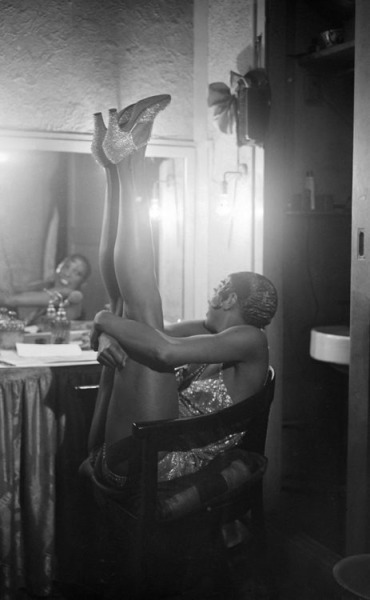

#vintagestagehotties#vintage tournament#vintagestagepoll#vintage poll#vintage ladies#ladies round 5#julie andrews#josephine baker
21 notes
·
View notes
Text
horror movies i've watched this year:
abigail*
lisa frankenstein*
talk to me
late night with the devil
longlegs
the howling
blood quantum*
titane
frankenhooker*
possession
ganja & hess*
the first omen*
the birds
house of wax*
a bucket of blood
I married a witch (not horror but halloween-y)*
the innocents*
a bay of blood
(some of) black sabbath
the house that dripped blood*
brain damage*
the blob (1988)*
pumpkinhead
infinity pool
the fall of the house of usher
immaculate
the deliverance
basket case
vampyr (1932)
the black cat (1941)
the black cat (1934)
dead of night (1945)
night/curse of the demon (1957)
dracula (1958)
onibaba*
blood and black lace*
hour of the wolf
the wicker man (1973)
phantom of the paradise*
invasion of the body snatchers (1978)*
the changeling
tenebrae*
christine*
slumber party massacre ii
dr jekyll and mr hyde
night of the creeps
near dark*
there's nothing out there
body bags*
the frighteners
tales from the hood*
funny games (didn't finish)
disturbing behavior
pulse*
the host*
[rec]
eden lake
triangle*
attack the block*
it comes at night
annihilation
climax
gaia
i saw the tv glow
we're all going to the world's fair
maxxxine
elvira's haunted hills
#might have missed one or two...#i used to keep a list on imdb but i haven't updated that in forever#'hayley you should get a letterbox then' no<3#personal
13 notes
·
View notes
Note
What’s the history of the Bloody Mary cocktail?
In 1917, Chef Louis Perrin, working in a hotel in French Lick, Indiana (what a name for a place) ran out of oranges and used tomatoes instead, inventing tomato juice as we know it today.
(Citation needed, this is a topic with a fair amount of discussion and it's almost certain that Perrin did not actually invent tomato juice. I mean... it's juiced tomato, a fair argument is that it's nature's creation or Gods', whatever keeps your boat afloat. It is mainly put to emphasize that the popularity of tomato juice was burgeoning or resurging at this time.) (I do think he was the first to use it in drinks? But I haven't done any juice research, I beg of you, there is other stuff to talk about (although now; I am intrigued.)
it should also explain why then, in France 1921, we finally have our first claim of the Bloody Mary!
Stating that Fernand Petoit created it in the New York Bar (Now called Harry's New York Bar) in Paris.
The confusion starts here folks!
I don't quite believe Fernand Petoit was the originator of the Bloody Mary. Frankly I'd love to be proven wrong and have this be the easiest question to answer so I can move on with the rest of it's history, but there are two things that frustrate me to think about.
1: I can only find the claim of 1921 being attributed to his grand daughter, rather than him directly. I'd be inclined to just believe historical wear-and-tear on this one, but:
2: He does have a direct quote in 1934 that describes a modernization of the Bloody Mary:
" -it was really nothing but vodka and tomato juice when I took it over"
I may be picking at words. But who says 'take it over' when they are confidently sure they've created it, If it were 1921 -way before all other claims?
To clarify, he's also right. He took the Bloody Mary and ran with it, most people site him as the creator for certain.
All the stories from here get even less clear, to prepare you.
If we zoom a decade forward to the early 1930s, and across the globe to actual New York: We find Henry Zibikiewicz.
There is almost zero information about Henry Zbikiewicz I could find, apart from that he worked as a bartender at 21 Club in New York, and that the bar claims he invented the Bloody Mary.
Let's take a short interval to talk about Henry Zbikiewicz and dead-end research.
I am under the belief that Henry Zbikiewicz was a bartender at 21 Club, and existed. I have found many different utterly too brief ancestry reports and other personal profiles of him (that state that he lived and died, but nothing else), besides this I have no confirmation.
While I would love to search the ends of the earth to discover the truth behind him and his background, I know it either does not exist, or doesn't exist to be found by amateur researchers (self-reference). A lot of information these days is behind pay-walls and internet dives about as deep as the Mariana (trench), and I unfortunately do not have all the time in the world.
What is especially upsetting for me though is finding enough.
I'm certain he existed.
I'm certain he lived.
I am not certain on anything else.
Let's take a longer interval on the nature of death and memory, along my journey to finally discover the Tumblr max word count.
Throughout my life I have always enjoyed graveyards. They are quiet, serene, undeniably holy/weird/sacred/creepy (change as required); the perfect place to be alone with this feeling of connection still running through the stones and the ground you walk beneath.
I'm quoted as saying 'I could die before you' as a small child, in response to my mother telling us about her refusing medications.
I feel as if this explains my relationship with death quite well, I was aware of it and have interacted with it in a casual way for my whole life.
Ramble, ramble, blah, blah, blah, this is all to say:
I don't fear death. I don't remember a time in my life I did fear death, honestly.
But; being forgotten?
That has always terrified me more than perhaps anything else in this world.
So the grim reaper will have to hold off. Till I do something memorable (I already have, and so have you, it's called being loved and loving).
I hope Henry Zbikiewicz is resting comfortably, I hope somewhere there's a family that is his or a friend that has told a tale of him.
These aren't answerable research questions, they'd be intrusive to find the answers to if they were, but they are so hyper-specific I doubt anyone has taken the time to find and ask.
I'd like to offer my favourite remembrance ritual to you, in trade for giving you existential dread: Go into a graveyard, find a grave (I prefer the older ones or ones that are not up kept, but any is perfectly fine) and recite their name for the week.
This way their memory continues, a little tiny bit of it. A name, alas cannot possibly contain all the things that anything is and was, or all the journeys it went down to end in our same shared fate of belonging to the ground.
A Bloody Mary is in this way quite cyclical. Tomatoes natively grow in France, so along with being a cheap post-war resource, (and good lord did France take a huge blow after The Great War (or WW1) but this is a different subject) it is a symbol of new life. Vodka, is a process of decomposition and fermentation (as all alcohols are) and so I feel represents death in a way.
The other well-known (how much knowledge do normal people have of any of this?) story of invention includes George Jessel, noted 1920's comedian and a socialite named Mary (which is where I swiftly transition from invention to naming).
Apparently he fixed the concoction in order to sober up quickly while hiding the smell of alcohol from his wife, then, when his friend Mary asked to try, it was spilled on her. To which she reportedly said:
'Now you can call me Bloody Mary!'
From the 1920's (anecdotal) it is posited that it was made for a Vladimir Smirnoff (yes, of vodka fame) and named Bloody Mary after the inability to pronounce the Slavic syllables in the name (???).
That absolutely STUMPED me until I actually said it aloud a couple times, in a really bad French accent. The 'Vl' quickly turns into a 'Bl' and can see how the rest slips into place. I hope it was something they were laughing about rather than laughing At Vladimir for.
But according to the manager of that same bar (In the 1920's again, he claims), the drink was named after the first person who ordered it. The first said it reminded him of his girlfriend, who he met in a cabaret called The Bucket Of Blood (naming convention match, not the same show), her name of course being Mary.
But! In the 1930's, where Fernand's cocktail is confirmed, he says himself it was called the 'Red Snapper'!
It was called the 'Mary Rose' in a publication from El Floridita in 1939, and claimed as a new cocktail in Life magazine (MAY be the December 7, 1942 magazine as I can find no other mention of drinks on the extensive list of life magazines (yes I looked through all of them)) as the 'Red Hammer'.
So, everyone says something different, and you have to be a special kind of crazy to look through all of it (you're welcome).
There's one more story, and then I'll leave you, I do hope this has been entertaining, I have worked really hard at this in my spare time to make this awful jumbling mass of spoken word information. I do think I've failed slightly at that.
I'm sure all you brits have been waiting, but bide your time just a couple more seconds before I say one more thing:
There is another story of the Bloody Mary, but I don't want to tell it, because it's not history yet. The violent crime in Chicago and the amount of bars playfully nicknamed 'The Bucket of Blood' there over the years are a later claim to the Bloody Mary. It's a story of a waitress called Mary at one of these 'Buckets' and as much as I think that deserves light shed on it, frankly my mental state is not stable enough to.
I want to try my best to be an ethical source of information, and because of this I do want to mention it, but a longer discussion is not going to be healthy for me right now.
So, with that in mind, I have one last story to tell you.
The nickname 'Bloody Mary' for Mary Queen of Scots, or Mary I is first seen written in a historical series by Charles' Dickens named 'A Child's History of England' in early 1851 to late 1853.
She got her name from the over 280 protestants she had burned during her reign (July 1553- 17 November 1558), although it's disputed whether she was called 'Bloody Mary' by her protestant opponents.
Although this name is indisputably much older than any of the 1900's claims to the name 'Bloody Mary', it's hard to pinpoint if it is the true origin for the cocktail being called the 'Bloody Mary'. If it is the true origin, the people who invented the cocktail have tried very hard to find original reasons to call it that. If it isn't true, it is an odd but not implausible coincidence.
In the very end, when all the Mary dust has settled and all the peppercorns have been crushed into the mix, it's always a story of history and memory.
When the tomatoes are squeezed, the vodka added or left out, celery or parsley garnish presented, lemon juice, salt or just tomato juice.
What is the history of the Bloody Mary?
And who says there has to be one?
My first Bloody Mary was in London in a restaurant I don't remember the name of, before seeing Hadestown, a musical about memory and oral tradition, for my longstanding historical advisor (bullshit checker) 's birthday, it's all memory and perception, even at the beginning.
Now, in this moment, and in the past already for those reading (and you, future Tyler, editor extraordinaire). I sit eating eggs and drinking coffee and writing in a cafe I frequent in my town.
There will be a day I don't remember what the interior looks like, how the coffee tastes, what books I rest one of my arms on, and maybe it will haunt me, or maybe I won't care.
If you haven't had a Bloody Mary before, do!
It might not be your cup of Mary, but it tastes like spicy gazpacho soup and I really like it.
There will be a day you don't remember where you were when you first sipped one, what it tasted like, how much pepper was in it, what kind they used, if it had a full stick of celery in it or just the leafy bits or if it had no garnish at all-
-and maybe it will haunt you. You might go back on your memory and overwrite a grand experience of falling off a cliff, Bloody Mary clasped in one hand as the rocks narrowly avoided, you might tell yourself the harsh bite of the wind rushing by you, you may create perilous rocks below;
or maybe you won't care.
But wouldn't you rather have it (the memory) and decide how you feel about it later?
Try new things, or historical revisionism is kinda fine, whichever lesson you'd rather take,
Enjoy your Bloody Mary.
-Ace x
Indirect/various sources:
-A few drinks blog: Who invented the original bloody mary?
-Fernand Petiot: Wiki and Granddaughter blog post
-Life magazine 1942 Archives
-It always begins with a simple search. (Bloody Mary wiki)
Big thanks Henry Zbikewicz, and all the beautiful stories people tell about things, for existing.
And my Sibling, or my historical advisor, for giving me this idea at the restaurant. I almost lost my mind TWICE (Henry Zbikewicz and trying to find the exact Life volume) but it was overall, a very enjoyable experience.
Maybe the next post will take me less than 3 months to write! I doubt it, but the night is young.
#interesting#writing#i love writing#history#is confusing#like seriously#does anyone ever really know?#or are we all just guessing at who Knows what and who thinks they know what#research#memory#good lord I actually don't know how long this took me#too long
7 notes
·
View notes
Text
Peter Lorre & Celia Lovsky
Let's have a round-up!
1929

Peter Lorre and Celia Lovsky in the Black Forest of southwestern Germany, December. (Peter proposed to Celia at Christmas that year!)
1932

Peter and Celia back in the Black Forest, on holiday.
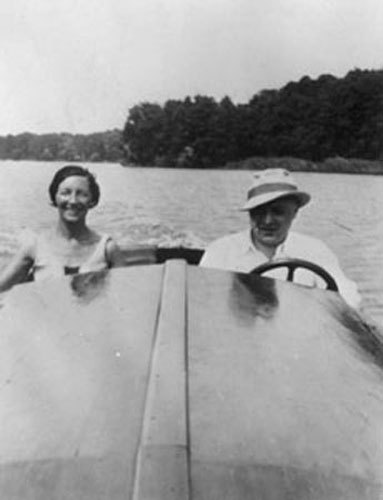
Peter and Celia motor-boating on der Wannsee, in the southwestern Berlin borough of Steglitz-Zehlendorf.
1934


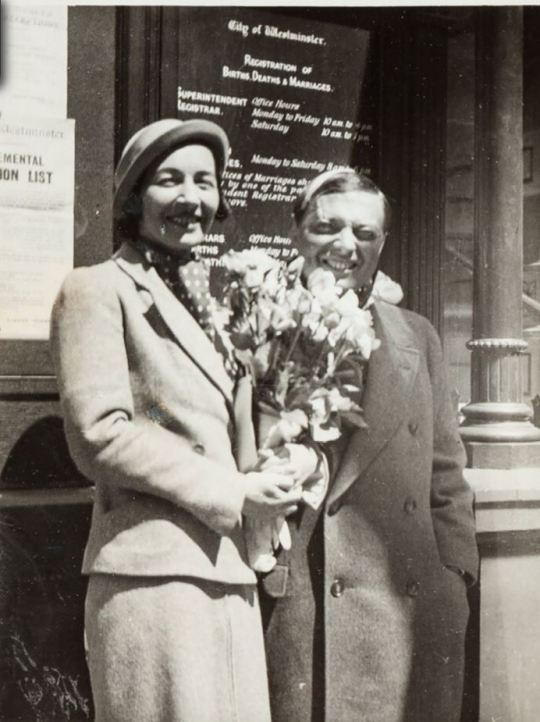
Marriage time!

July 18, leaving London for Hollywood.
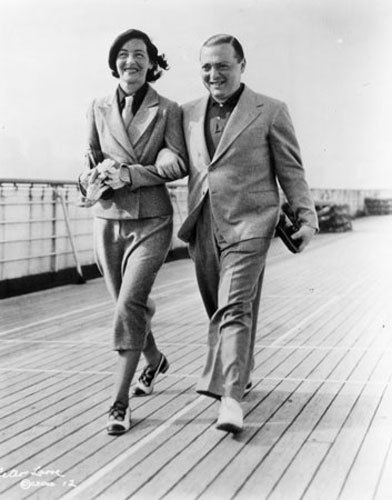
Peter and Celia aboard the Cunard White Star Liner Majestic bound for New York, mid-July.
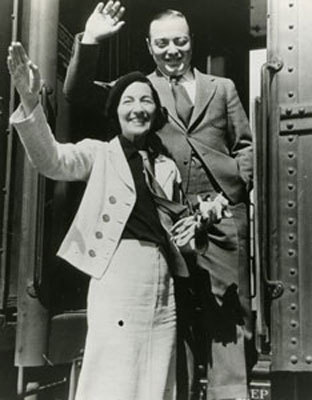
I'm not sure if the above is a 1934 picture or not, but they did have to take a train again once they got off the oceanliner...
More under the cut
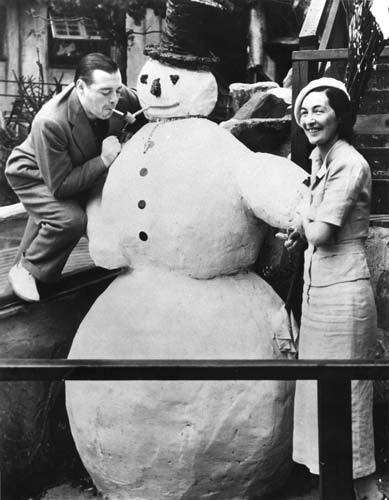
On the way to Hollywood in July, Peter and Celia changed trains in Chicago and took time to visit the 1933-34 World’s Fair. Peter is pretending to light his cigarette from a snowman in the Black Forest Village.

Also in July, Peter and Celia rented a house on 326 Adelaide Drive in Santa Monica. Whether or not they're really going to play badminton at that moment, that eyebrow steals the show.

But they did like to play!
1935
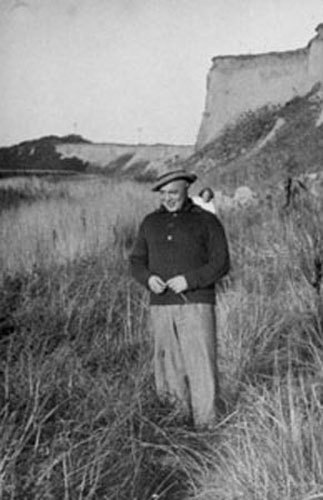
Peter and Celia taking a walk in the hills outside Santa Monica. His head was shaved for his role as Dr. Gogol in "Mad Love."

Peter and Celia arriving on the 20th Century.

Peter and Celia - I am not sure where they are.

Peter and Celia.
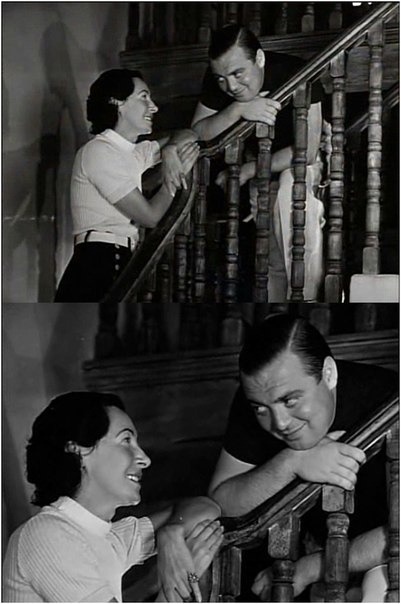
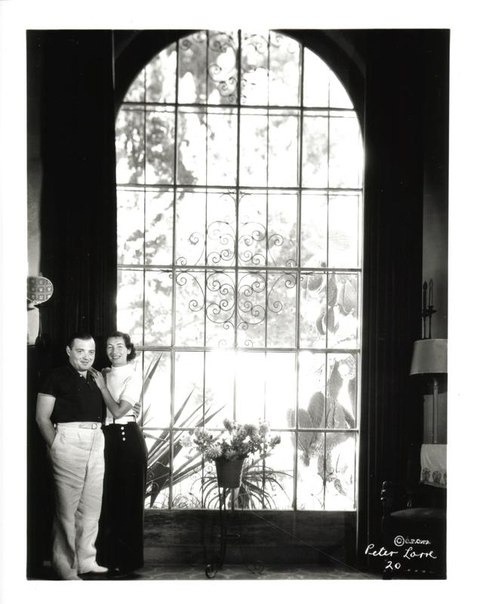

Peter and Celia, Columbia photoshoot.



The above three pics are Peter and Celia at a premiere, possibly for a Shirley Temple movie. Or something else.
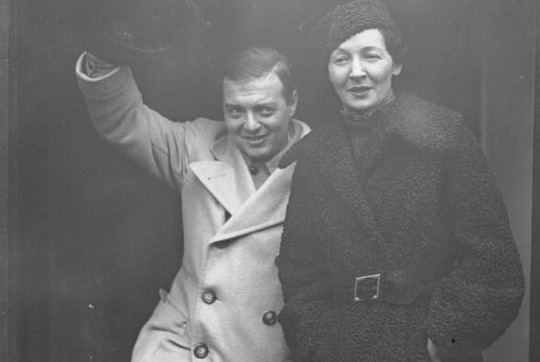
Peter and Celia arriving in Southhampton, England, Nov 7.
1936
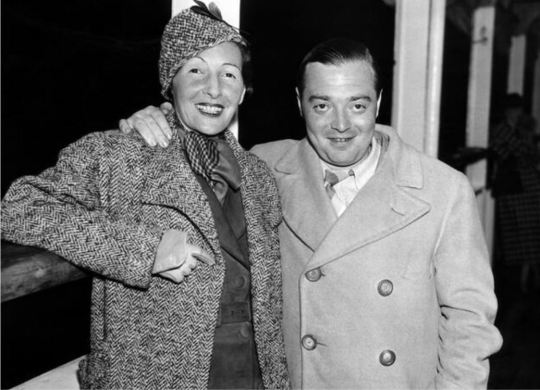
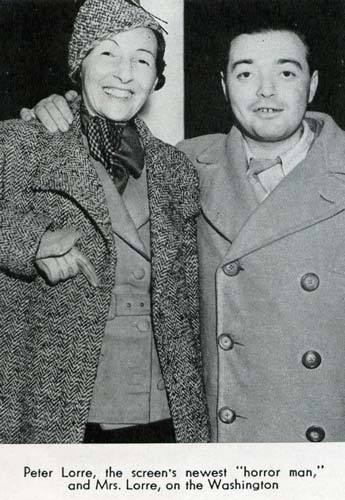
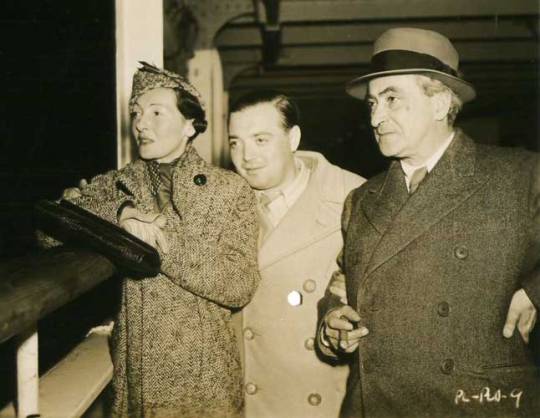
Celia, Peter, and German screenwriter and film director Berthold Viertel arrive in New York aboard the S.S. Washington, April 29, after "Secret Agent" was done filming.


Peter and Celia arriving in Hollywood.
Happy New Year
I don't know which new year it is, but it seems fitting to end this set with it:
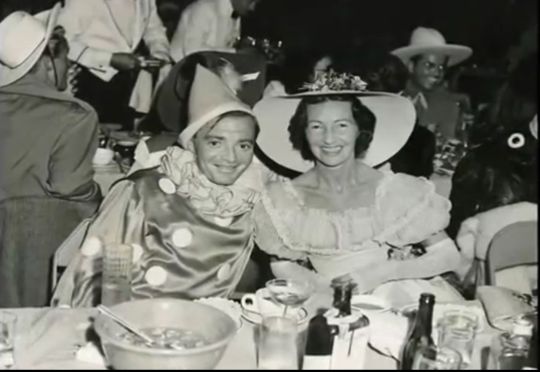
25 notes
·
View notes
Text
INTRO POST PART TWO THE SECOND
this is long
ok my name is mj. obviously. its short for mcjesus like the mcdonalds version of jesus. and also mortimer jebidiah. i have no gender (lost it in a game of blackjack unfortunately) so they/it/ any neos. im good with whatever besides he and she :3
movies i like- the saw franchise (!!!), the thing, the fly, princess bride, spiderverse, nimona, i saw the tv glow, we’re all going to the worlds fair, everything everywhere all at once, the sixth sense, the substance, the blob, fight club, american psycho, die welle. i like lots of movies :]
shows i like- dead boy detectives, the owl house, good omens, dont hug me im scared. uh i think thats it
books- six of crows (also all the leigh bardugo books ive read them all multiple times), all the andrew joseph white books, the raven cycle, all for the game, they both die at the end, the house in the cerulean sea, wilder girls, dune, the neverending story, etc etc i read a lot
music (i am autistic if you were wondering)- the crane wives, ewy, ajj, ghost mice, spoonboy, mal blum, bears in trees, mother mother, negative xp, cattle decapitation, ricky montgomery, cheap dirty horse, bird teeth, the butchies, team dresch, against me, the mechanisms, the scary jokes, mischief brew. i could go on (i also have second hand autism from my friend @b-movie-scream-king about murderdolls but i dont listen to them very much)
i draw sometimes (trad art because whenever i do online art i hate it very much) and write always. my ao3 is here and i post writing things sometimes
i loveeee the magnus archives its so frickin rad and i mod for a hc blog for it: @the-headcanon-archives
i also mod @feed-your-faves-to-mick which is totally normal and very serious
i have real bad anxiety so im sorry if i never talk to my mutuals and im bad at responding. i promise i love all my mutuals and i wanna talk to yall but idk how :/. i also hallucinate haha thats fun. im paranoid too.
i was born on September 11, 1934 at 4:20 am exactly. if you care about that shit.
oh yeah ima lesbian oriented aroace. my beloved wife is @w3bcu1t and she’s so cool go follow her NOW
i am normal about mkultra so dont even start
i think that’s all you need to know SEND ME ASKS IF YOU WANT TO KNOW MORE ABOUT ME IM A VERY OPEN PERSON I SWEAR


^those are my genders (they them fish and amanda young)
dni: (putting it here because it was in a reblog which meant i couldnt edit this post)
queerphobes, ableists, racists, antisemitists, zionists, xenophobes, pedos, terfs, etc etc (writing this made me sad why are there so many flavors of discrimination??)
idc about whatever else if i dont like you i wont iinteract with you 👍
10 notes
·
View notes
Text
Ruth Ben-Ghat at Lucid:
The benchmark of democratic political systems used to be elections, and the practice of holding elections was often used to determine whether a country could be classified as a democracy. Today, as "electoral autocracies" take hold around the world, that's no longer the case. Many illiberal leaders come to power through elections, and then manipulate the electoral system to get the results they need to stay in office. As the U.S. election approaches, it’s useful to remember that the history of autocracy is the history of war on the idea and practice of free and fair elections. For authoritarian leaders on the right and the left, allowing a population to determine through their votes who is in government and for how long is unthinkable. Why should lesser beings decide the fate of the strongman, who alone can lead the nation to greatness?
Fascist dictator Benito Mussolini derided elections as a “childish game” that had “already humiliated the nation for decades.” Il Duce replaced democratic elections with occasional plebiscites. In 1934, as he prepared to invade Ethiopia and was dealing with increased internal unrest, he staged a vote. Italians were actually weighing in on a purge of the political class: a single list he had approved of nominees for seats in Parliament, with the choices YES or NO. The real point of the exercise was to show Italians and the world that he had popular approval for his governmental measures. To that end, voting was “assisted” by Fascist "poll watchers," (squadrists in black shirts, armed with knives), and the regime’s communications about the vote can be summed up as “vote yes or else,” in the Fascist manner. This propaganda piece, on the façade of Palazzo Braschi in the center of Rome, depicted Mussolini's face as a kind of death mask, suggesting what could happen to those who voted no. The result of the plebiscite --99.85% YES, and only .15% NO--suggests that Italians got the message.
Today’s autocrats may keep elections going, but they won’t hesitate to game the competition by finding ways to silence rivals. Here’s Turkish President Recep Tayyip Erdoğan in 2018 when CNN asked him if he was a dictator. "Here we have a ballot box...the democracy gets its power from the people. It's what we call national will," But in advance of the 2023 Turkish presidential contest, Erdoğan sentenced popular Istanbul Mayor Ekrem İmamoğlu to several years in jail. That way İmamoğlu could not be the opposition candidate. The newer autocratic tactic, facilitated by disinformation, is to discredit elections before the election is held so the public will believe you when you say, in the event of defeat, that the whole contest was “rigged” against you or invalidated by fraud. If the authoritarian is able to marshal his party and allies into sustaining the falsehood in public, then the idea of an illegitimate election can gain traction. This is called institutionalized lying: when a lie that is particularly important to the leader and his survival in politics becomes party doctrine. Then anyone who wants to have status in the authoritarian party or state must perform the lie in public, or at least refuse to refute it. Propagandists know that a lie, when repeated with enough frequency, becomes familiar and eventually can be taken as truth.
[...] The outcome of this scenario In Brazil offers an example of gatekeeping as democracy protection. After President Jair Bolsonaro lost the 2022 election, he decided to try and replicate the Donald Trump playbook, claiming that the election was rigged and planning an insurrection for January. Stephen Bannon and Jason Miller were among his advisors. Lack of military participation was among the reasons for the failure of Bolsonaro’s insurrection. Brazil had a military coup in 1964, which led to a military dictatorship that only ended in 1985. Brazilian President Luiz Inácio Lula da Silva acted promptly to prosecute participants. In 2023, Bolsonaro was convicted of abuse of power in office and banned from running for office until 2030 for spreading lies about election fraud. In America, Trump, who incited a far bloodier insurrection, continues to maintain he won the 2020 election as he prepares to possibly contest the 2024 outcome. Trump has worked hard for almost a decade to get Americans to give up their quaint ideas about voting as a valued democratic right. He has conditioned them to see democracy as a failing system, and to view elections as an inferior and unreliable way to choose leaders.
Ruth Ben-Ghiat’s Lucid post on how elections are the enemy of the autocrat is a must-read.
#Autocracy#Donald Trump#Benito Mussolini#Fascism#Authoritarianism#Illiberal Democracy#Recep Tayyip Erdoğan#Ekrem İmamoğlu#Jair Bolsonaro#Luiz Inácio Lula da Silva
6 notes
·
View notes
Text

Alexander Raymond Katz "Sandor" (1895-1974) “Chicago World’s Fair - See, Hear, Play - A Century of Progress” (1934) Source
6 notes
·
View notes
Note
for the WIP ask game... The Future Is Still Silver and Black? (original train fiction from you two sounds really interesting!)
So last year, I went up north to visit Ray. Ray lives in Chicago, which just so happens to have the largest railway museum in the United States, the Illinois Railway Museum.
At the IRM, we saw the Nebraska Zephyr, which is a streamlined stainless steel articulated trainset. Each of the cars in this train are named after Greek/Roman goddesses. Venus, Vesta, Minerva, Ceres, and Juno. It's really quite striking. And the train is pulled by an EMD E5 (the only surviving E5 in fact) named Silver Pilot.

The next day we went to the Museum of Science and Industry. There we saw the Pioneer Zephyr, the first of the Burlington Zephyrs.

So after we get out of the MSI, we're sitting in the Metra station, waiting for the train, and we're doing Independent Research on our phones. Because the concept of the Nebraska Zephyr is great, right? Five beautiful cars all named after goddesses. And that is when we learn that Silver Pilot did not originally belong to this train.
"Those aren't even his bitches," Ray said to me.
So over the next few months, we did more Independent Research. And every new piece of information we found about Silver Pilot just made his story even better. The whole thing is fuckin' wild and we had to DIG to find almost all of it. It's insane because the engine has this amazing story - a story that Ray often points out would sound contrived if it wasn't true - and apparently no one has cared until a pair of fucking cunt dorks went to the train museum.
Comparatively, the Pioneer Zephyr was easy to find more about. Its history is extremely well-documented and lots of people in the past have been fucking cunt dorks about that train. The thing about the Pioneer Zephyr though is that it was made in the early 30's, right? And Burlington promoted this train in a way almost... vaudevillian. It broke the land speed rail record on its way to its debut at the 1934 World's Fair (outdoing its competitor from the Union Pacific, M-10000 only a couple months after it broke the record), it went on an exhibition tour, there were commemorative letter covers given for its service milestones, there was a ride-on children's toy made of it, it starred in a movie!
So me and Ray were now thoroughly enthralled by these two separate but related trains and how different their service lives were - and continue to be - when we get an idea.
We'd considered the idea of trains writing letters to each other before, but it's a little human for them in general, particularly for working engines who are busy. Although I was quite pleased when I was able to report to Ray that there was indeed an episode of TTTE where Thomas sends Percy a postcard.
But these guys are both preserved and while Pilot still works, the IRM is only really open on weekends. They got time. They have people with hands who can read and write who also have time.
DJ: Oh, what if they send each other letters? Ain't like they've got anything else going on. Ray: c2c. I was thinking about them being pen pals. Especially since they live so close, the letters don't take long to arrive. They can be short and sweet. DJ: Gives them something to look forward to. Ray: You can send some a few times a year and not be overwhelming with the information.
Which was all well and good, but then I found something practically serendipitous. A sign that this was the way to go.
So remember how Pioneer had all these publicity stunts and events done for it? On its tenth anniversary, they made a six foot birthday cake and rigged up an eight-foot-long knife such that the train could pull forward, break a ribbon, and cut its own birthday cake.

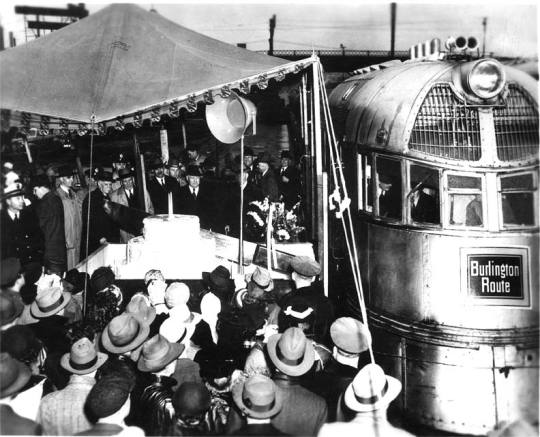
Most of this cake was given to veteran and child hospital patients, but individual pieces were also sent off to each of Pioneer's "brothers" and a hundred-ish other fellow streamliners across the country.
With a letter.
DJ: Raymond. There's a train letter IN the Pioneer Zephyr book. FROM the Pioneer Zephyr. About his birthday party. Although he does say in it that he only has brothers. Ray: OH MY GOD. How did we know??? Are we just that fucking good???? Do we just know and perceive the truth THAT well. DJ: It's too fucking cute. Ray: The fact that he is a he and also says he has brothers is revolutionary. That almost strains the limits of credulity, knowing how Train Guys are about calling engines "she". But I know you would not lie to me about this. Can you scan it?????

The fucking train actually, canonically, wrote a letter.
So yeah, the trains are pen pals. And they write to each other about their past and but moreso about their present. Because as it happens, their history post-preservation is interesting too (as I'm sure you can relate) and there's far less said about it already.
The first batch of letters are done, we're just getting some other materials together before we can publish.
EDIT: people are reblogging this again so just editing to add that you can read the train letters here.
105 notes
·
View notes
Text

Bas-relief entitled “Atomic Energy” at The Century of Progress, Chicago Worlds Fair, 1933, 1934.
Chicago, Illinois, USA
#art deco#art deco design#art deco architecture#art deco style#Chicago#Illinois#worlds fair#bas relief
151 notes
·
View notes